The process of brewing kombucha involves nurturing a living entity, making the choice of location for your brewing vessels a crucial one. The yeast and bacteria in kombucha interact with their environment, hence the importance of the location. We will dig into the optimal brewing location for Kombucha in this article.
This holds particularly true for your first fermentation vessels, which should be covered only by a breathable cotton cloth. The location for the second fermentation, when your kombucha is bottled and sealed, is less critical, but there are still best practices to follow for both stages of fermentation. If you haven’t done so already, consider reading my post on temperature, as it will guide you in choosing the most conducive environment for your brewing vessels.
First fermentation (F1), Location Tips:
Ensure good airflow. Steer clear of confined or musty, dusty areas. Your SCOBY (Symbiotic Culture Of Bacteria and Yeast) could absorb musty odors from bacteria thriving in enclosed spaces. Cupboards, especially those prone to moisture or dampness, are not ideal. Moisture combined with closed spaces creates a perfect environment for mold. Spotting mold in a dark kitchen cabinet can be challenging. If you unknowingly have a moldy cabinet and decide to store your brew vessel there, you risk ending up with a moldy brew.
Some brewers prefer closets or pantries. If these spaces are large enough and you frequently open and close the doors to allow airflow, this could work. However, if you choose to store it in your coat closet, bear in mind that kombucha can sometimes emit a pungent or acidic odor, which could permeate your clothes.
Avoid Sunlight & Chemicals…

Avoid direct sunlight. This is more of a precaution than a strict rule. Occasional exposure to sunlight won’t immediately harm the bacteria in your SCOBY or kombucha vessels. However, prolonged exposure to sunlight should be avoided as it can have antimicrobial or antibacterial properties, which is counterproductive to the bacteria-rich environment you want to foster in your brew vessel.
Keep away from harsh chemicals. Avoid spraying air fresheners or cleaning products near your brew vessels. Your SCOBY could absorb these chemicals, even in small quantities, which could lead to its death or disrupt its symbiosis.
Avoid proximity to garbage. This is self-explanatory. You don’t want your SCOBY absorbing bacteria or odors from your trash. Mold is also common in trash cans or trash bags.
Maintain distance from other fermenting foods. If you ferment other foods at home, like beer, kefir, yogurt, or sourdough, it’s advisable to keep some distance between them and your kombucha to prevent cross-contamination.
Second fermentation Location (F2), Tips and Tricks
The second fermentation, also known as F2, is a crucial step in the kombucha brewing process. During this stage, the kombucha undergoes carbonation, resulting in a fizzy and flavorful beverage. To ensure a successful second fermentation, it’s important to choose the optimal brewing location for kombucha. In this article, we will explore the key factors to consider when selecting the perfect spot for your kombucha’s second fermentation.
Maintaining the right temperature is crucial for a successful second fermentation. The ideal temperature range for kombucha fermentation is between 70°F and 85°F (21°C and 29°C). It’s important to choose a location that remains within this range consistently. Avoid areas that are prone to temperature fluctuations, such as near windows or heating vents. A stable temperature will promote the growth of beneficial bacteria and yeast, resulting in a well-carbonated and flavorful kombucha.
Ventilation & Sanitization…

Proper ventilation and airflow are essential during the second fermentation process. The fermentation produces carbon dioxide, which needs to escape to prevent excessive pressure buildup in the bottles. Choose a location that allows for adequate airflow to prevent the accumulation of carbon dioxide. However, be cautious not to expose the kombucha to drafts, as they can disrupt the fermentation process. A well-ventilated area, such as a kitchen countertop or a pantry with good air circulation, is ideal for the second fermentation.
Maintaining a clean and sanitized brewing environment is crucial to prevent contamination and ensure the quality of your kombucha. Choose a location that is easy to clean and sanitize, such as a dedicated brewing area or a clean kitchen counter. Avoid areas that are prone to dust, dirt, or other potential contaminants. Regularly clean and sanitize your brewing vessels, utensils, and the surrounding area to minimize the risk of unwanted bacteria or mold growth.
Again, Avoid Sunlight but think about Convenience
During the second fermentation, it’s important to protect your kombucha from direct sunlight. Sunlight can have antimicrobial properties that may hinder the growth of beneficial bacteria and yeast. Choose a location away from direct sunlight or use opaque bottles to shield your kombucha from light. A dark pantry or cupboard can be an ideal spot for the second fermentation, as long as it provides proper ventilation and temperature control.
Consider the accessibility and convenience of the brewing location. You will need to monitor the progress of your kombucha during the second fermentation, including checking for carbonation levels and taste testing. Choose a location that is easily accessible and allows you to observe and interact with your brewing vessels without any hassle. This will make it easier to maintain and adjust the fermentation process as needed.
Wrapping Up
Finding the optimal brewing location for fermentation of your kombucha is crucial for achieving a fizzy, flavorful, and high-quality beverage. Consider factors such as temperature control, ventilation, cleanliness, light exposure, and accessibility when selecting the perfect spot. By creating an environment that promotes the growth of beneficial bacteria and yeast, you can ensure a successful second fermentation and enjoy the delightful taste of homemade kombucha.
Remember, experimentation and observation are key to finding the best brewing location that suits your specific brewing conditions and preferences. Happy brewing y’all!
Sources:
- Kombucha Kamp. “Second Fermentation: How to Make Fizzy Kombucha.” Kombucha Kamp
- Kombucha Home. “Second Fermentation: How to Make Your Kombucha Fizzy.” Kombucha Home
- The Kitchn. “How to Make Fizzy Kombucha Tea.” The Kitchn
Want to Learn More about Kombucha? See additional blog posts below:







